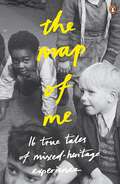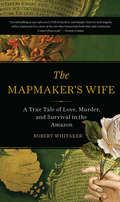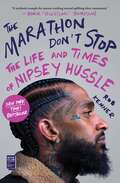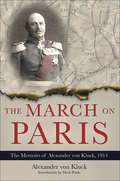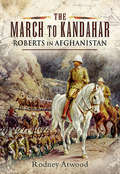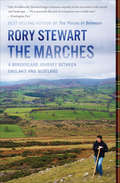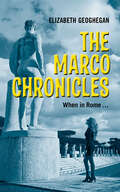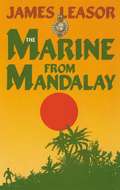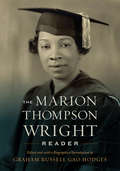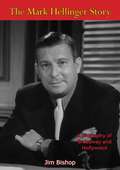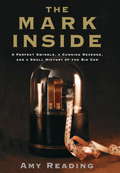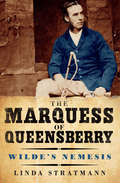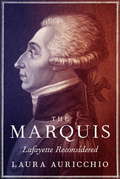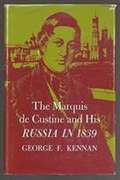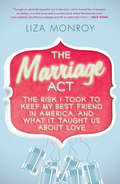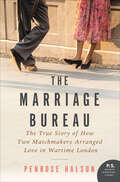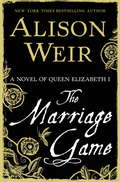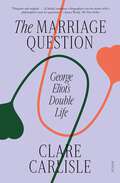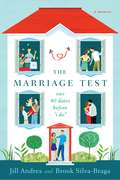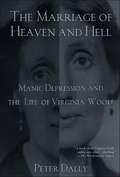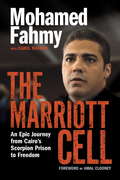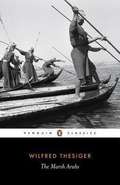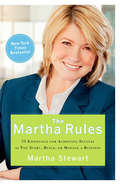- Table View
- List View
The Map of Me: True Tales of Mixed-Heritage Experience
In today's Britain thousands of people have parents from different cultural backgrounds. In February 2008 we asked for people from any background to send us true stories which illuminate the complexities, challenges and joys of having a mixed heritage - those defining moments which seem to say it all. Then we asked six judges - including the novelist Kate Mosse and Shami Chakrabati from Liberty - to choose the best, most searching accounts to be included in this anthology. The resulting stories are as varied and colourful as they are true, honest and moving, but through all of them runs a universal theme: the desire to know and understand our own identity, and to forge a sense of self that surpasses the complex layers of places, parents and the past.
The Mapmaker's Wife: A True Tale Of Love, Murder, And Survival In The Amazon
by Robert WhitakerIn 1735 a team of French scientists set out on a daring expedition into the South American wilderness to resolve one of the great scientific challenges of the time: the precise size and shape of the Earth. Scaling the Andes and journeying along the Amazon, the mapmakers faced all manner of danger, while madness, disease and violent death each took their toll. However one, Jean Godin, fell in love with a local girl called Isabel Grameson. When the time came for the expedition to return to France, Godin travelled ahead to ensure the way was safe for his new family. But on reaching French Guiana, disaster struck: Spain and Portugal closed their borders and he was stranded, unable to return to Isabel. What followed lies at the core of this extraordinary tale - a heartbreaking 20-year separation that ended when Isabel, believing she might never see her husband again, decided to make her own way across the continent: a journey that began in hope but became hell on earth. . . Drawing on his own experience retracing Isabel's epic trek as well as contemporary records, Robert Whitaker recounts a captivating true story of love and survival set against the backdrop of what many still regard as 'the greatest expedition the world has ever known'.
The Marathon Don't Stop: The Life and Times of Nipsey Hussle
by Rob KennerA NEW YORK TIMES BESTSELLER This &“beautiful tribute to a legendary artist&” (Quincy Jones) is the first in-depth biography of Nipsey Hussle, the hip-hop mogul, artist, and activist whose transformative legacy inspired a generation with his motivational lyrics and visionary business savvy—before he was tragically shot down in the very neighborhood he was dedicated to building up. For Nipsey Hussle, &“The Marathon&” was more than a mixtape title or the name of a clothing store; it was a way of life, a metaphor for the relentless pursuit of excellence and the willpower required to overcome adversity day after day. Hussle was determined to win the race to success on his own terms, and he wanted to see his whole community in the winner&’s circle with him. A moving and powerful exploration of an extraordinary artist, The Marathon Don&’t Stop places Hussle in historical context and unpacks his complex legacy. Combining on-the-ground reporting and candid interviews, &“Rob Kenner has given us the book the world—and hip-hop and pop culture—has been waiting for…one that should be celebrated alongside the best biographies ever about iconic figures we have loved—and lost&” (Kevin Powell, author of When We Free the World).
The March on Paris: The Memoirs of Alexander von Kluck, 1914
by Alexander von KluckVon Kluck saw active military service at an early age during the Seven Weeks' War of 1866 and, in 1870-71, the Franco-Prussian War. Rising through the army, he became inspector general of the Seventh Army District in 1913.During the First World War von Kluck commanded the German First Army, notably in the Schlieffen Plan offensive against Paris at the start of the war in August 1914. An aggressive commander, von Kluck's impatience (at the request of Second Army commander von Bulow - who was unwilling to allow gaps to appear in the German front - he switched his advance south and east of Paris rather than the planned north and west), allied with a lack of direction from the German High Command and effective French and British counter-attacks, led to the failure of the Schlieffen offensive.Von Kluck's role in the plan was to command the extreme right of the German forces in attacking the left flank of the French army and encircling Paris, bringing a rapid conclusion to the war.After capturing Brussels on 20 August, von Kluck was almost successful in defeating France, his forces being halted a mere 13 miles from the French capital in the First Battle of the Marne from 6-9 September 1914. His forces had earlier fought costly battles against the British at Mons and at Le Cateau. With the suspension of the German offensive the nature of the battle changed to one of trench warfare, remaining essentially static until the end of the war.Von Kluck was himself seriously wounded in the leg in March 1915, retiring from active service the following year in October 1916.
The March to Kandahar: Roberts in Afghanistan
by Rodney AtwoodThe story of the British commander who led a three-hundred-mile march from Kabul to Kandahar and became the toast of Victorian England. This book examines the role of Frederick Roberts in the Second Anglo-Afghan War, culminating in his famous march in 1880 with ten thousand British and Indian soldiers, covering three hundred miles in twenty-three days, from Kabul to Kandahar to defeat the Afghan army of Ayub Khan, pretender to the Amirship of Kabul. The march made Roberts one of late Victorian England&’s great military heroes, partly because of the achievement itself, partly because the victory restored British prestige after defeat, and finally because of Roberts&’ astute use of the press to puff his victory. This overcame the earlier damage done to his reputation by the political storm that followed his hanging of over eighty Afghans in revenge for the massacre of a British envoy and his escort. It enabled the liberal Viceroy of India, Lord Ripon, to extract his forces from an Afghan imbroglio with prestige restored and an emir on the Afghan throne who for thirty-nine years maintained friendship with British India. Roberts (or Bobs as he was known) subsequently advanced to command the Indian Army, working closely with future viceroys to influence Indian defense policy on the North-West Frontier, and being hymned by Rudyard Kipling, poet of empire. His bestselling autobiography, Forty-One Years in India, established his image before the British public and he remains one of Britain&’s best known, if least understood, military figures
The Marches: A Borderland Journey Between England and Scotland
by Rory StewartFrom a member of Parliament and best-selling author of The Places in Between, an exploration of the Marches—the borderland between England and Scotland—and the political turmoil and vivid lives that created it.In The Places in Between, Rory Stewart walked some of the most dangerous borderlands in the world. Now he travels with his eighty-nine-year-old father—a comical, wily, courageous, and infuriating former British intelligence officer—along the border they call home.On Stewart’s four-hundred-mile walk across a magnificent natural landscape, he sleeps on mountain ridges and in housing projects, in hostels and farmhouses. With every fresh encounter—from an Afghanistan veteran based on Hadrian’s Wall to a shepherd who still counts his flock in sixth-century words—Stewart uncovers more about the forgotten peoples and languages of a vanished country, now crushed between England and Scotland.Stewart and his father are drawn into unsettling reflections on landscape, their parallel careers in the bygone British Empire and Iraq, and the past, present, and uncertain future of the United Kingdom. This is a profound reflection on family, landscape, and history by a powerful and original writer.“An unforgettable tale.” — National Geographic“The miracle of The Marches is not so much the treks Stewart describes, pulling in all possible relevant history, as the monument that emerges to his beloved father.” — New York Times Book Review
The Marco Chonicles
by Elizabeth GeogheganIn this hilarious, irreverent, flash memoir, a young American expat arrives in Rome to find handsome, charming men, breathtakingly beautiful antiquities, and perfectly made cappuccino. What more could anyone want? But after a few too many romantic mishaps, she discovers the so-called dolce vita comes at a price. With a jaded eye, but a vulnerable heart, short story writer Elizabeth Geoghegan takes us on a literary Sex in the City romp through Rome. The Marco Chronicles shows us what life in Italy looks like when you' re 30-something, running from grief, and trying to find a way back to love.
The Marine from Mandalay
by James LeasorA real-life World War II tale of survival and perseverance against overwhelming odds from the international bestselling author of Passport to Oblivion. This is the true story of William Doyle, a Royal Marine wounded by shrapnel in Mandalay who undergoes a long solitary march through the whole of Burma to flee the Japanese. He then finds his way back through India and back to Britain to report for duty in Plymouth. On his way Doyle has many encounters and adventures and helps British and Indian refugees. He also has to overcome complete disbelief that a single man could walk out of Burma with nothing but his orders—to report to HQ—and his initiative.
The Mario Garcia Omnibus E-book
by Mario T. GarcíaThis Omnibus E-Book brings together Mario Garcia's landmark books on Latino Studies. The Latino Generation: Voices of the New AmericaLatinos are already the largest minority group in the United States, and experts estimate that by 2050, one out of three Americans will identify themselves as Latino. Though their population and influence are steadily rising, stereotypes and misconceptions about Latinos remain, from the assumption that they refuse to learn English to questions of just how "American" they actually are. By presenting thirteen riveting oral histories of young, first-generation college students, Mario T. Garcia counters those long-held stereotypes and expands our understanding of what he terms "the Latino Generation."Blowout!: Sal Castro and the Chicano Struggle for Educational JusticeThis fascinating oral history transcribed and presented in Castro's voice by historian Mario T. Garcia, is a compelling, highly readable narrative of Castro, a young boy growing up in Los Angeles who made history by his leadership in the blowouts and in his career as a dedicated and committed teacher.
The Marion Thompson Wright Reader: Edited and with a Biographical Introduction by Graham Russell Gao Hodges
by Marion Manola Thompson WrightIn The Marion Thompson Wright Reader, acclaimed historian Graham Russell Hodges provides a scholarly, accessible introduction to a modern edition of Marion Thompson Wright’s classic book, The Education of Negroes in New Jersey and to her full body of scholarly work. First published in 1941 by Teachers College Press, Thompson’s landmark study has been out of print for decades. Such rarity understates the book’s importance. Thompson’s major book and her life are significant for the histories of New Jersey, African Americans, local and national, women’s and education history. Drawing upon Wright's work, existing scholarship, and new archival research, this new landmark scholarly edition, which includes an all-new biography of this pioneering scholar, underscores the continued relevance of Marion Thompson Wright.
The Mark Hellinger Story: A Biography of Broadway and Hollywood
by Jim BishopMark Hellinger, beloved newspaperman, whose Broadway column was read daily by 22,000,000 people, and whose years as a Hollywood producer were marked by such outstanding successes as “High Sierra,” “The Killers,” and “Naked City,” died in 1947 in his forty-fifth year. In this book, Jim Bishop, who was his secretary, takes us behind the scenes to live again, the life of a man who “went everywhere, saw everything, and did everything—without exultation or remorse.”Rich with the nostalgic echoes of a note-too-distant past, THE MARK HELLINGER STORY is a magnificent account of a fabulous era—Broadway of the twenties and thirties, from the colossal glamour of the Follies, Vanities, and Scandals to the trenchant wit and lilting tunes of the Little Shows, with the heady smell of printer’s ink and the roar of the night presses; the vast canvas of Hollywood in the silent days, and its sudden rebirth with sound.It is the story, too, of a man who crammed into a lifetime more living than most people will ever know. In the words of Jim Bishop, Hellinger “spent time as though he had stolen it and couldn’t find a fence.”
The Mark Inside: A Perfect Swindle, a Cunning Revenge, and a Small History of the Big Con
by Amy ReadingIn 1919, Texas rancher J. Frank Norfleet lost everything he had in a stock market swindle. He did what many other marks did--he went home, borrowed more money from his family, and returned for another round of swindling. Only after he lost that second fortune did he reclaim control of his story. Instead of crawling back home in shame, he vowed to hunt down the five men who had conned him. Armed with a revolver and a suitcase full of disguises, Norfleet crisscrossed the country from Texas to Florida to California to Colorado, posing as a country hick and allowing himself to be ensnared by confidence men again and again to gather evidence on his enemies. Within four years, Frank Norfleet had become nationally famous for his quest to out-con the con men. Through Norfleet's ingenious reverse-swindle, Amy Reading reveals the mechanics behind the scenes of the big con--a piece of performance art targeted to the most vulnerable points of human nature. Reading shows how the big con has been woven throughout U.S. history. From the colonies to the railroads and the Chicago Board of Trade, America has always been a speculative enterprise, and bunco men and bankers alike have always understood that the common man was perfectly willing to engage in minor fraud to get a piece of the expanding stock market--a trait that made him infinitely gullible. Amy Reading's fascinating account of con artistry in America and Frank Norfleet's wild caper invites you into the crooked history of a nation on the hustle, constantly feeding the hunger and the hope of the mark inside.
The Marquess of Queensberry
by Linda StratmannThe Marquess of Queensberry is as famous for his role in the downfall of one of our greatest literary geniuses as he was for helping establish the rules for modern-day boxing. The trial and two-year imprisonment of Oscar Wilde, lover of Queensberryâ TMs son, Lord Alfred Douglas, remains one of literary historyâ TMs great tragedies. However, Linda Stratmann's riveting biography of the Marquess paints a far more complex picture by drawing on new sources and unpublished letters. Throughout his life, Queensberry was emotionally damaged by a series of tragedies, and the events of the Wilde affairâ "told for the first time from the Marquessâ TMs perspectiveâ "were directly linked to Queensberryâ TMs personal crises. Through the retelling of pivotal events from Queensberryâ TMs lifeâ "the death of his brother on the Matterhorn and his fruitless search for the body; the suicides of his father, brother, and eldest sonâ "the book reveals a well-meaning man often stricken with a grief he found hard to express, who deserves our compassion.
The Marquis
by Laura AuricchioA major biography of the Marquis de Lafayette, French hero of the American Revolution, who, at age nineteen, volunteered to fight under George Washington; a biography that looks past the storybook hero and selfless champion of righteous causes who cast aside family and fortune to advance the transcendent aims of liberty and justice commemorated in America's towns, streets, parks, and schools named after the French nobleman. Laura Auricchio gives us a rich portrait of the man, fully revealed, a man driven by dreams of glory and felled by tragic, human weaknesses. In The Marquis, we come to understand the personal struggles, social quandaries, and idealistic visions that inspired an orphaned young man to cross an ocean and fight a war that was none of his concern; we see a guileless provincial whose unexpected inheritance allowed him to marry into the highest echelons of the French aristocracy, and become a self-consciously awkward presence at the palace of Versailles. Here is the young Lafayette, removed from the French army as a result of sweeping reforms, trapped in a gilded cage until American emissaries reached Paris seeking support for their revolution. In the American cause, Lafayette, whose only vision had been of martial glory, saw a way to reach his dreams, and seized it with gusto. Americans welcomed him with open arms, and he returned their affection fully. His American éclat was so brilliant and his enthusiasm so great that he quickly became the symbol of the Franco-American alliance that ultimately defeated Great Britain. We see how Lafayette's reputation rose to great heights during the American Revolution but collapsed during the French; that when the Bastille fell on July 14, 1789, Parisians hailed Lafayette as the French Washington and appointed him commander of their National Guard, hoping that he would be able to restore order to a city wracked by starvation and violence. As revolutionaries hurtled in radical directions and staunch monarchists dug in their heels, Lafayette lost control, remaining steadfast in his belief that the French monarchy needed to be reformed but not abolished, and doing everything in his power to prevent an American-style republic from taking root in his native land. Formerly seen as France's heroic figure, Lafayette was now viewed as opportunistic, a dreamer, and a traitor to his nation--and today remains a murky figure in French memory. In America, Lafayette's momentous departure from his homeland for the War of Independence has long been hailed as the start of an extraordinary career to be celebrated for generations. In France, it is often seen as just one of his many misbegotten undertakings. Yet no one has managed to offer a satisfactory answer to the crucial question of why: Why did Americans shower Lafayette with so much acclaim in his own time that he remains a hero today, being named an honorary U.S. citizen in 2002--becoming only the seventh person ever granted this distinction? And why, in contrast, does his memory continue to be denigrated in his own land? Auricchio, drawing on substantial new research conducted in libraries, archives, museums, and private homes in France and the United States, gives us history on a grand scale as she answers these crucial questions, revealing the man and his complex life, and challenging and exploring the complicated myths that have surrounded his name for more than two centuries.From the Hardcover edition.
The Marquis de Custine and His Russia in 1839
by George F. KennanA critical study of the study of the Marquise de Custine.
The Marriage Act: The Risk I Took to Keep My Best Friend in America, and What It Taught Us About Love
by Liza MonroyAfter her traditional engagement to her high school sweetheart falls apart, Liza Monroy faced the prospect of another devastating loss: the deportation of her best friend Emir. Desperate to stay in America, Emir tried every legal recourse to obtain a green card knowing that his return to the Middle East-where gay men are often beaten and sometimes killed-was too dangerous. So Liza proposes to Emir in efforts to keep him safe and by her side. After a fast wedding in Las Vegas, the couple faces new adventures and obstacles in both L.A. and New York City as they dodge the INS. Their relationship is compounded further by the fact that Liza's mother works for the State Department preventing immigration fraud. Through it all, Liza and Emir must contend with professional ambition, adversity, and heartbreak and eventually learn the true lessons of companionship and devotion. This marriage that was not a marriage, in the end, really was.The Marriage Act is a timely and topical look at the changing face of marriage in America and speaks to the emergent generation forming bonds outside of tradition-and sometimes even outside the law.
The Marriage Bureau: The True Story of How Two Matchmakers Arranged Love in Wartime London
by Penrose HalsonA riveting glimpse of life and love during and after World War II—a heart-warming, touching, and thoroughly absorbing true story of a world gone by.In the spring of 1939, with the Second World War looming, two determined twenty-four-year-olds, Heather Jenner and Mary Oliver, decided to open a marriage bureau. They found a tiny office on London’s Bond Street and set about the delicate business of matchmaking. Drawing on the bureau’s extensive archives, Penrose Halson—who many years later found herself the proprietor of the bureau—tells their story, and those of their clients. From shop girls to debutantes; widowers to war veterans, clients came in search of security, social acceptance, or simply love. And thanks to the meticulous organization and astute intuition of the Bureau’s matchmakers, most found what they were looking for. Penrose Halson draws from newspaper and magazine articles, advertisements, and interviews with the proprietors themselves to bring the romance and heartbreak of matchmaking during wartime to vivid, often hilarious, life in this unforgettable story of a most unusual business.“A book full of charm and hilarity.”—Country Life
The Marriage Game: A Novel of Queen Elizabeth I (Elizabeth I)
by Alison WeirIn this compelling novel of Tudor drama and suspense, acclaimed author Alison Weir brings to life one of England's most scandalous royal love affairs: the romance between the "Virgin Queen" Elizabeth I and her courtier Lord Robert Dudley. Only twenty-five and newly crowned, Elizabeth vows to rule the country as both queen and king. But her counselors continually press her to form an advantageous marriage and produce an heir. Though none of the suitors have yet worked their way to her throne, the dashing--though married--Lord Robert lays claim to Elizabeth's heart. Their flagrant flirting, their unescorted outings, and the appointment of Lord Robert to Master of Horse inspire whispers through the court, and even rumors that Elizabeth has secretly given birth to Lord Robert's child. Events take a dark turn when Robert's wife is found dead. Universal shock is followed by accusations of murder. Despite the scandal, Elizabeth and Robert manage to navigate the choppy political, economic, and religious waters around them. But the greatest obstacle to marriage between the Queen and her true love may come not from outside forces, but from within. With intricate period detail and captivating prose, Alison Weir explores one of history's most provocative "Did they or didn't they?" debates. The Marriage Game maneuvers through the alliances, duplicities, intrigue, and emotions of a woman intent on sovereignty--over her country and herself. Praise for Alison Weir A Dangerous Inheritance "A juicy mix of romance, drama and Tudor history . . . pure bliss for today's royal watchers."--Ladies' Home Journal "Highly compelling [with] plenty to keep readers enthralled."--Historical Novel Review Captive Queen "Should be savored . . . Weir wastes no time captivating her audience."--Seattle Post-Intelligencer "Stunning . . . As always, Weir renders the bona fide plot twists of her heroine's life with all the mastery of a thriller author, marrying historical fact with licentious fiction."--The Denver Post The Lady Elizabeth "Intrigue and maneuverings. Scandal. Schemers and innocents put to death. [This] history of Tudor England is an engrossing story. . . . Weir marries conjecture with what is known about the life of Elizabeth I from childhood to coronation, and it makes for ripping good reading."--Milwaukee Journal Sentinel "A compelling, even irresistible, read."--Booklist (starred review)
The Marriage Question: George Eliot's Double Life
by Clare CarlisleNamed one of the ten Best Reviewed Nonfiction Books of 2023 by Literary Hub A startling new portrait of George Eliot, the beloved novelist and a rare philosophical mind who explored the complexities of marriage.In her mid-thirties, Marian Evans transformed herself into George Eliot—an author celebrated for her genius as soon as she published her debut novel. During those years she also found her life partner, George Lewes—writer, philosopher, and married father of three. After “eloping” to Berlin in 1854, they lived together for twenty-four years: Eliot asked people to call her "Mrs Lewes" and dedicated each novel to her "Husband." Though they could not legally marry, she felt herself initiated into the "great experience" of marriage—"this double life, which helps me to feel and think with double strength." The relationship scandalized her contemporaries yet she grew immeasurably within it. Living at once inside and outside marriage, Eliot could experience this form of life—so familiar yet also so perplexing—from both sides. In The Marriage Question, Clare Carlisle reveals Eliot to be not only a great artist but also a brilliant philosopher who probes the tensions and complexities of a shared life. Through the immense ambition and dark marriage plots of her novels, we see Eliot wrestling—in art and in life—with themes of desire and sacrifice, motherhood and creativity, trust and disillusion, destiny and chance. Carlisle's searching new biography explores how marriage questions grow and change, and joins Eliot in her struggle to marry thought and feeling.Includes black-and-white images
The Marriage Test
by Jill Andres Brook Silva-BragaA crash course in commitment: one couple and forty dates that could make or break their marriage before the wedding. Picking a partner is life's most important decision, but how are we supposed to make it? Being in love is a good start, but the issues that ultimately wreck marriages--money and monogamy, career and kids--are hard to gauge until you're actually hitched. So after a few years of dating, Jill Andres and Brook Silva-Braga built The Marriage Test to confirm their compatibility before saying "I do." Forty revealing challenges simulate the issues that could tank or strengthen their union. For a month, they swap credit cards, for a weekend they borrow a baby. An embarrassing lunch with their exes tests their trust issues. Sexual gymnastics are required to recreate TV love scenes. From a night of speed dating to 24 hours handcuffed together, the crazy, awkward, emotional trials fling them headfirst into assorted marital minefields. Is their love strong enough to weather real life? Only forty dates will tell...From the Trade Paperback edition.
The Marriage of Heaven and Hell: Manic Depression and the Life of Virginia Woolf
by Peter DallyCombining his knowledge as a doctor and a lifelong fascination with Virginia Woolf's life and work, eminent psychiatrist Peter Dally offers a haunting and compelling look at the depression that tormented Virginia Woolf throughout her adult years, in The Marriage of Heaven and Hell: Manic Depression and the Life of Virginia Woolf.On three occasions Virginia went mad. Symptoms of these episodes included conversations with her dead mother, and hearing birds speak in Greek. Though a quiet life cushioned her childhood, the renown that Woolf achieved through writing inspired the bouts of depression and elation that she regularly experienced as an adult. This terrified Virginia, and though the experience offered extraordinary insight into her craft, Woolf lived in constant fear of her dreadful affliction.Virginia's most vital protection from stress was her husband, Leonard. Without his constant vigilance and care, it is doubtful she would have been so creatively productive. Yet, paradoxically, their marriage ultimately precipitated her most dangerous bout of madness. Toward the end of her life, when events outside the couple's control led to Leonard's own depression and gradual withdrawal, Virginia found herself facing madness alone, and with tragic results.Compassionate and disturbing, this fascinating study is the first to look at Virginia Woolf's life from the perspective of her illness.
The Marriott Cell: An Epic Journey from Cairo's Scorpion Prison to Freedom
by Carol Shaben Amal Clooney Mohamed FahmyAward-winning journalist Mohamed Fahmy's widely anticipated account of his wrongful incarceration in Cairo's maximum-security Scorpion Prison for terrorists and political leaders, and his subsequent battle for justice, opens a remarkable window onto the closed world of Islamic fundamentalism and the bloody geopolitical struggles that dominate our headlines. An important book that reads like a political thriller, it is also a testament to the critical importance of journalism today; an inspiring love story that made front-page news; and a profoundly personal drama of one man's fight for freedom. On the night of December 29, 2013, Egyptian security forces, in a dramatic raid on the Marriott Hotel, seized Fahmy (Canadian-Egyptian Bureau Chief for Al Jazeera English) and two of his colleagues, Peter Greste and Baher Mohamed, accusing them of fabricating news as members of the outlawed Muslim Brotherhood. Their trials became a global cause célèbre condemned as a travesty. But Fahmy also never stopped being a journalist: inside Scorpion he found himself cheek by jowl with notorious Muslim Brotherhood leaders, Al Qaeda fighters, and ISIS sympathizers. Always intrepid, he took advantage of the situation to "interview" the Brotherhood about their aims, gaining exclusive insight into the geopolitical feuds between Egypt, Saudi Arabia, and the UAE on one hand and Qatar and its allies, including Turkey on the other--interviews that led him to sue his former employer, Al Jazeera, from prison. The complex power brokering of Middle Eastern and Western governments left three men trapped in a web he describes as "Global McCarthyism." But at the heart of the book is an inspiring story of two strong women: Fahmy's wife, Marwa Omara, who used every means possible to fight for his release, bravely risking her safety; and his courageous international human-rights lawyer, Amal Clooney, who championed his battle for freedom.From the Hardcover edition.
The Marsh Arabs
by Wilfred Thesiger Jon Lee AndersonDuring the years he spent among the Marsh Arabs of southern Iraq-long before they were almost completely wiped out by Saddam Hussein-Wilfred Thesiger came to understand, admire, and share a way of life that had endured for many centuries. Traveling from village to village by canoe, he won acceptance by dispensing medicine and treating the sick. In this account of a nearly lost civilization, he pays tribute to the hospitality, loyalty, courage, and endurance of the people, and describes their impressive reed houses, the waterways and lakes teeming with wildlife, the herding of buffalo and hunting of wild boar, moments of tragedy, and moments of pure comedy in vivid, engaging detail.
The Martha Rules: 10 Essentials for Achieving Success as You Start, Build, or Manage a Business
by Martha StewartMartha Stewart is an undeniable force in the business world. One of the world's greatest entrepreneurs, she turned her personal passion into Martha Stewart Living Omnimedia, a billion dollar business. Now, for the first time, Martha Stewart shares her business knowledge and advice in this handbook for success. Tapping into her years of experience in building a thriving business, Martha will help readers identify their own entrepreneurial voice and channel their skills and passions into a successful business venture. Her advice and insight is applicable to anyone who is about to start or expand a venture of any size, whether it is a business or philanthropic endeavor, but also to individuals who want to apply the entrepreneurial spirit to a job or corporation to increase innovation and maintain a competitive edge.Featuring Martha's top principles for success, as well as stories and anecdotes from her own experiences, The Martha Rules is sure to appeal to business readers, fans, and anyone who admires her for her style, taste, and great advice-and who have great business ideas of their own.
